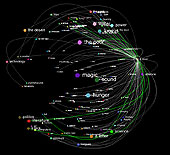:: Monday, April 11, 2005 ::
Under Fire.2 : The Organization and Representation of Violence
Edited::Jordan Crandall
Rotterdam : Witte de With Center for Contemporary Art, 2005
ISBN 90-73362-65-2
Under Fire explores the organization and representation of contemporary armed conflict. This book, part of the project’s second phase, involves discussions between artists, theorists, scientists, critics, activists, and journalists on a wide array of issues around warfare and representation. The topics covered in this volume include the militarization of urban space; architectures and ontologies of targeting; cultures of suspicion; the epistemology of global infrastructures; the exhibition of atrocity; panopticism and disappearance; simulated and imagined constructions of territory; and the corporate use of force.
Contributors include: Ryan Bishop, Benjamin Bratton, David Campbell, Gregory Clancey, James Der Derian, Madelaine Drohan, Paul N. Edwards, Joy Garnett, Salwa Ghaly, Irving Goh, Stephen Graham, Chris Hables Gray, Anahid Kassabian, Thomas Keenan, Mary Keller, Bracha Lichtenberg Ettinger, Saba Mahmood, Antonio Monegal, Amir Parsa, John William Phillips, Amit Rai, Harel Shapira, Radhika Subramaniam, Ananya Vajpeyi, Ana Valdes, and Nabeel Ziad.
Under Fire is a project by Jordan Crandall organized by Witte de With, center for contemporary art, in collaboration with V2_Institute for the Unstable Media, Rotterdam.
http://www.wdw.nl
 Online.Project Review: Spheres--Santiago Ortiz
Online.Project Review: Spheres--Santiago OrtizBY Eduardo Navas
Many online projects rely on users' contributions to be completed, and since database aesthetics became more common thanks to technologies like php and Flash MX to facilitate information, artists have developed intriguing online projects.
Spheres by Santiago Ortiz is a recent example of this. It presents a Flash interface that allows users to contribute short texts (phrases or short sentences) to an ever-growing database. Users can contribute in three languages English, Spanish or Portuguese. The content is presented in form of a sphere (hence the name spheres). Each sphere has a set of terms that can be connected to other terms by the user. If any two terms had been previously connected, then the current user can see what was written to then contribute another text.
The strength of the project is the urge for discovery, the potential to learn something by connecting two terms. A narrative is at play that is defined exclusively by the contributions; at the same time the narrative is limited by the pre-existing terms, which were chosen according to their importance in the sciences, while also being common in everyday language. The ongoing narrative denies any particular outcome other than the archiving of users' personal understanding of two words. It is always decentered and without a specific goal. It can never be completely understood as a concise and definite body of writing, especially because it is ever-growing in three different languages. That these languages are separated is something that exposes the dynamics of the Internet--that of language barriers not being erased by network technologies, but rather reinforced. There apparently is a sphere that combines all languages, but I did not see the terms being crossreferenced.
Spheres is an interesting take on information exchange. Its interface is certainly worth playing around with, and one is invited to consider the reasoning behind the terms that were chosen. The selection of 122 scientific terms may actually reveal more about the author than he may intend. Spheres appears to be a collaboration where the author is defined by the readers.